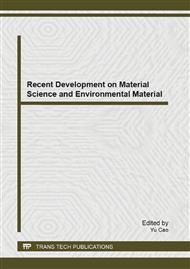[1]
Shiq C and iln HB, The status and development of gas atomization for Production of Metal Powder[J]. Powder Metallurgy Technology, 2004. 10, 22(5): 6.
Google Scholar
[2]
Dowson A, Atomization dominates powder production: The growth of atomization was much in evidence at the World Congress[J]. Metal powder report, 1999, 54: 15-17.
DOI: 10.1016/s0026-0657(99)80162-3
Google Scholar
[3]
Boll R, soft magnetic materials [M]. Beijing China metallurgical industry press. 1985: 5-23.
Google Scholar
[4]
Degauque J, Bouchara D, Fagot M, Effect of order-disorder transition on magnetic properties of rapidly solidified high-silicon iron ribbons[J]. Magnetics, IEEE Transactions on, 1990, 26(5): 2220-2222.
DOI: 10.1109/20.104677
Google Scholar
[5]
Li M, Birringer R, Johnson W, Nanocrystalline Fe--Si phase by mechanical attrition and its soft magnetic properties[J]. Nanostructured Materials, 1993, 3(1-6): 407-412.
DOI: 10.1016/0965-9773(93)90106-l
Google Scholar
[6]
Ding J, Li Y, Chen L, Microstructure and soft magnetic properties of nanocrystalline Fe–Si powders[J]. Journal of alloys and compounds, 2001, 314(1): 262-267.
DOI: 10.1016/s0925-8388(00)01234-2
Google Scholar
[7]
R.S. Tebble and D.J. Craik, Magnetig materials [M]. Wiley-Interscience London. 1969: 118.
Google Scholar
[8]
Roy RK, Panda A, Ghosh M, Effect of annealing treatment on soft magnetic properties of Fe-6. 5 wt% Si wide ribbons[J]. Journal of Magnetism and Magnetic Materials, 2009, 321(18): 2865-2870.
DOI: 10.1016/j.jmmm.2009.04.052
Google Scholar
[9]
Song C and Zhao S, Effect of Nucleation Ability on Solidification Microstructure in Gas-atomized Fe-6. 5wt. %Si Alloy Powder [J]. 2012 [submited].
Google Scholar
[10]
Bolfarini C, Silva MCA, Jorge AM et al, Magnetic properties of spray-formed Fe–6. 5% Si and Fe–6. 5% Si–1. 0% Al after rolling and heat treatment[J]. Journal of Magnetism and Magnetic Materials, 2008, 320(20): e653-e656.
DOI: 10.1016/j.jmmm.2008.04.104
Google Scholar
[11]
Roy RK, Panda A, Ghosh M, Effect of annealing treatment on soft magnetic properties of Fe–6. 5 wt% Si wide ribbons[J]. Journal of Magnetism and Magnetic Materials, 2009, 321(18): 2865-2870.
DOI: 10.1016/j.jmmm.2009.04.052
Google Scholar
[12]
Lambri O, Pérez-Landazábal J, Salvatierra L, Secondary recrystallization in Fe–6. 5 wt% Si alloys by internal friction[J]. Journal of non-crystalline solids, 2001, 287(1): 70-74.
DOI: 10.1016/s0022-3093(01)00542-7
Google Scholar


